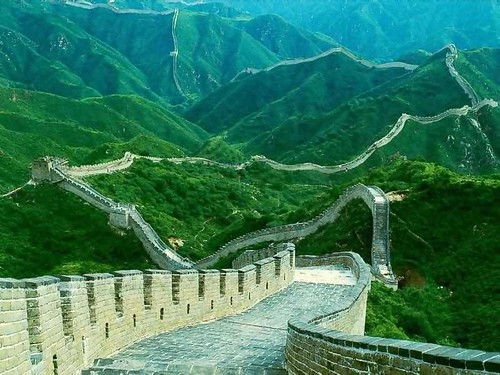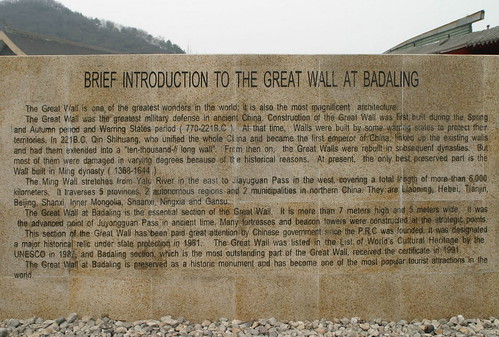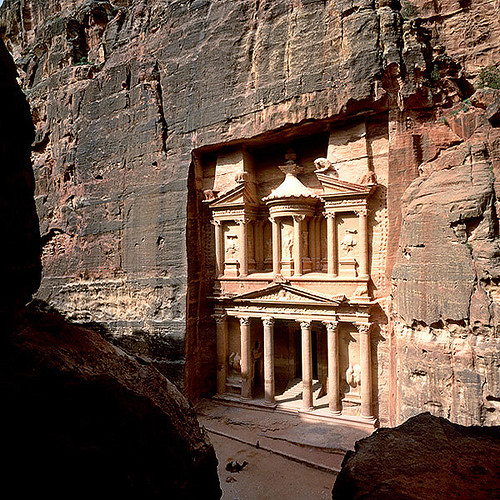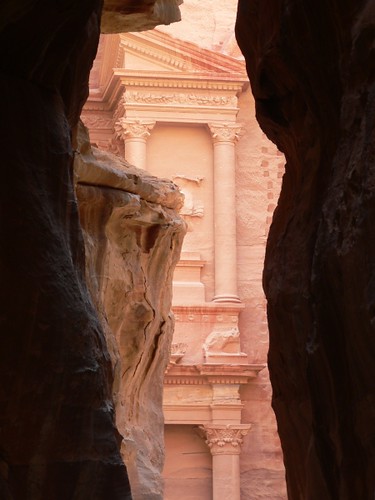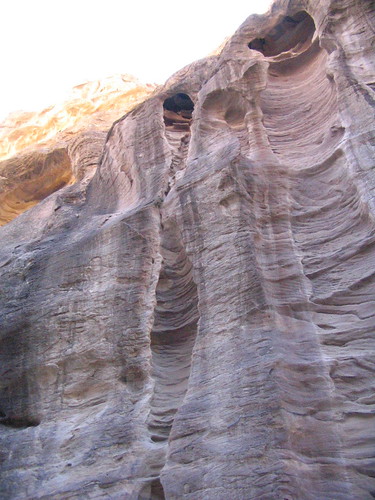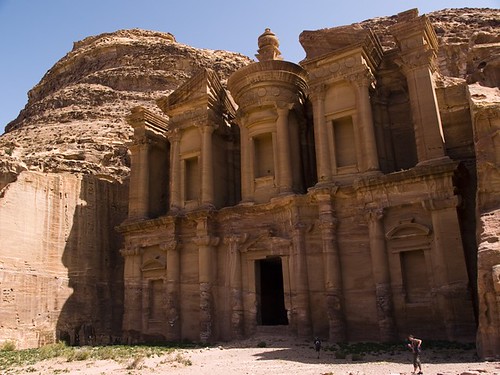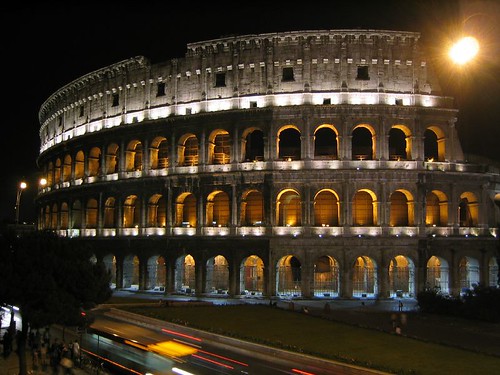 The Colosseum or Coliseum, originally the Flavian Amphitheatre (Latin: Amphitheatrum Flavium, Italian Anfiteatro Flavio or Colosseo), is an eliptical amphitheatre in the centre of the city of Rome, Italy, the largest ever built in the Roman Empire. It is one of the greatest works of Roman architecture and engineering.
The Colosseum or Coliseum, originally the Flavian Amphitheatre (Latin: Amphitheatrum Flavium, Italian Anfiteatro Flavio or Colosseo), is an eliptical amphitheatre in the centre of the city of Rome, Italy, the largest ever built in the Roman Empire. It is one of the greatest works of Roman architecture and engineering.Occupying a site just east of the Roman Forum, its construction started between 70 and 72 AD under the emperor Vespasian and was completed in 80 AD under Titus, with further modifications being made during Domitian's reign.
Originally capable of seating around 50,000 spectators, the Colosseum was used for gladiatorial contests and public spectacles. It remained in use for nearly 500 years with the last recorded games being held there as late as the 6th century — well after the traditional date of the fall of Rome in 476. As well as the traditional gladiatorial games, many other public spectacles were held there, such as mock sea battles, animal hunts, executions, re-enactments of famous battles, and dramas based on Classical mythology. The building eventually ceased to be used for entertainment in the early medieval era. It was later reused for such varied purposes as housing, workshops, quarters for a religious order, a fortress, a quarry and a Christian shrine.
Although it is now in a ruined condition due to damage caused by earthquakes and stone-robbers, the Colosseum has long been seen as an iconic symbol of Imperial Rome. It is one of modern Rome's most popular tourist attractions and still has close connections with the Roman Catholic Church, the Pope leading a torchlit "Way of the Cross" procession to the amphitheatre each Good Friday.
Name
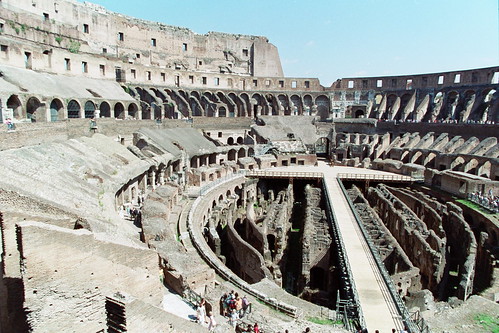 The Colosseum's name has long been believed to be derived from a colossal statue of Nero nearby. This statue was later remodeled by Nero's successors into the likeness of Helios (Sol) or Apollo, the sun god, by adding the appropriate solar crown. Nero's head was also replaced several times and substituted with the heads of succeeding emperors. Despite its pagan links, the statue remained standing well into the medieval era and was credited with magical powers. It came to be seen as an iconic symbol of the permanence of Rome.
The Colosseum's name has long been believed to be derived from a colossal statue of Nero nearby. This statue was later remodeled by Nero's successors into the likeness of Helios (Sol) or Apollo, the sun god, by adding the appropriate solar crown. Nero's head was also replaced several times and substituted with the heads of succeeding emperors. Despite its pagan links, the statue remained standing well into the medieval era and was credited with magical powers. It came to be seen as an iconic symbol of the permanence of Rome.In the 8th century, the Venerable Bede (c. 672–735) wrote a famous epigram celebrating the symbolic significance of the statue: Quandiu stabit coliseus, stabit et Roma; quando cadit coliseus, cadet et Roma; quando cadet Roma, cadet et mundus ("as long as the Colossus stands, so shall Rome; when the Colossus falls, Rome shall fall; when Rome falls, so falls the world"). This is often mistranslated to refer to the Colosseum rather than the Colossus (as in, for instance, Byron's poem Childe Harold's Pilgrimage). However, at the time that Bede wrote, the masculine noun coliseus was applied to the statue rather than to what was still known as the Flavian amphitheatre.
The Colossus did eventually fall, probably being pulled down to reuse its bronze. By the year 1000 the name "Colosseum" (a neuter noun) had been coined to refer to the amphitheatre. The statue itself was largely forgotten and only its base survives, situated between the Colosseum and the nearby Temple of Venus and Roma.
The name was further corrupted to Coliseum during the Middle Ages. Both names are frequently used in modern English, but Flavian Amphitheatre is generally unknown. In Italy, the amphitheatre is still known as il colosseo, and other Romance languages have come to use similar forms such as le colisée (French), el coliseo (Spanish) and o coliseu (Portuguese).
History
Ancient
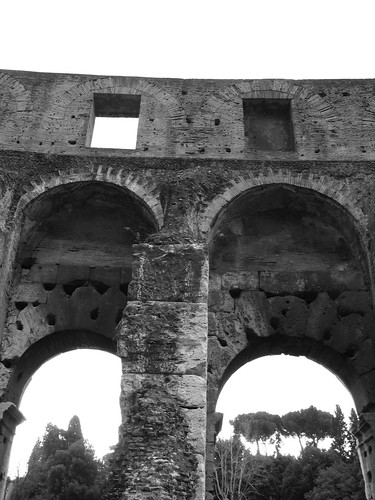 Construction of the Colosseum began under the rule of the Emperor Vespasian in around 70–72. The site chosen was a flat area on the floor of a low valley between the Caelian, Esquiline and Palatine Hills, through which a canalised stream ran. By the 2nd century BC the area was densely inhabited. It was devastated by the Great Fire of Rome in AD 64, following which Nero seized much of the area to add to his personal domain. He built the grandiose Domus Aurea on the site, in front of which he created an artificial lake surrounded by pavillions, gardens and porticoes. The existing Aqua Claudia aqueduct was extended to supply water to the area and the gigantic bronze Colossus of Nero was set up nearby at the entrance to the Domus Aurea.
Construction of the Colosseum began under the rule of the Emperor Vespasian in around 70–72. The site chosen was a flat area on the floor of a low valley between the Caelian, Esquiline and Palatine Hills, through which a canalised stream ran. By the 2nd century BC the area was densely inhabited. It was devastated by the Great Fire of Rome in AD 64, following which Nero seized much of the area to add to his personal domain. He built the grandiose Domus Aurea on the site, in front of which he created an artificial lake surrounded by pavillions, gardens and porticoes. The existing Aqua Claudia aqueduct was extended to supply water to the area and the gigantic bronze Colossus of Nero was set up nearby at the entrance to the Domus Aurea.The area was transformed under Vespasian and his successors. Although the Colossus was preserved, much of the Domus Aurea was torn down. The lake was filled in and the land reused as the location for the new Flavian Amphitheatre. Gladiatorial schools and other support buildings were constructed nearby within the former grounds of the Domus Aurea. According to a reconstructed inscription found on the site, "the emperor Vespasian ordered this new amphitheatre to be erected from his general's share of the booty." This is thought to refer to the vast quantity of treasure seized by the Romans following their victory in the Great Jewish Revolt in 70. The Colosseum can be thus interpreted as a great triumphal monument built in the Roman tradition of celebrating great victories. Vespasian's decision to build the Colosseum on the site of Nero's lake can also be seen as a populist gesture of returning to the people an area of the city which Nero had appropriated for his own use. In contrast to many other amphitheatres, which were located on the outskirts of a city, the Colosseum was constructed in the city centre; in effect, placing it both literally and symbolically at the heart of Rome.
The Colosseum had been completed up to the third story by the time of Vespasian's death in 79. The top level was finished and the building inaugurated by his son, Titus, in 80. Dio Cassius recounts that over 9,000 wild animals were killed during the inaugural games of the amphitheatre. The building was remodelled further under Vespasian's younger son, the newly-designated Emperor Domitian, who constructed the hypogeum, a series of underground tunnels used to house animals and slaves. He also added a gallery to the top of the Colosseum to increase its seating capacity.
In 217, the Coliseum was heavily damaged by a huge fire (caused by lightning, according to Dio Cassius), which destroyed the wooden upper floors of the amphitheatre, the interior fittings. It was not completely repaired, up to 240 additional repairs and underwent at 250 or 252 and 320. An inscription records the restoration of various parts of the Colosseum under Theodosius II and Valentinian III (reigned 425-450), maybe to repair the damage caused by a major earthquake in 443; more work was followed in 484 and 508th The arena continues to be used even for contests in the 6th Century, with at least 435 organized mentioned. Animal hunts continue until at least the 523rd
Medieval
The Colosseum underwent several radical changes of use during the medieval period. By the late 6th century a small church had been built into the structure of the amphitheatre, though this apparently did not confer any particular religious significance on the building as a whole. The arena was converted into a cemetery. The numerous vaulted spaces in the arcades under the seating were converted into housing and workshops, and are recorded as still being rented out as late as the 12th century. Around 1200 the Frangipani family took over the Colosseum and fortified it, apparently using it as a castle.
Severe damage was inflicted on the Colosseum by the great earthquake of 1349, causing the outer south side to collapse. Much of the tumbled stone was reused to build palaces, churches, hospitals and other buildings elsewhere in Rome. A religious order moved into the northern third of the Colosseum in the mid-14th century and continued to inhabit it until as late as the early 19th century. The interior of the amphitheatre was extensively stripped of stone, which was reused elsewhere, or (in the case of the marble facade) was burned to make quicklime. The bronze clamps which held the stonework together were pried or hacked out of the walls, leaving numerous pockmarks which still scar the building today.
Modern
 During the 16th and 17th century, Church officials sought a productive role for the vast derelict hulk of the Colosseum. Pope Sixtus V (1585–1590) planned to turn the building into a wool factory to provide employment for Rome's prostitutes, though this proposal fell through with his premature death. In 1671 Cardinal Altieri authorized its use for bullfights; a public outcry caused the idea to be hastily abandoned.
During the 16th and 17th century, Church officials sought a productive role for the vast derelict hulk of the Colosseum. Pope Sixtus V (1585–1590) planned to turn the building into a wool factory to provide employment for Rome's prostitutes, though this proposal fell through with his premature death. In 1671 Cardinal Altieri authorized its use for bullfights; a public outcry caused the idea to be hastily abandoned.
In 1749, Pope Benedict XIV endorsed as official Church policy the view that the Colosseum was a sacred site where early Christians had been martyred. He forbade the use of the Colosseum as a quarry and consecrated the building to the Passion of Christ and installed Stations of the Cross, declaring it sanctified by the blood of the Christian martyrs who perished there (see Christians and the Colosseum). Later popes initiated various stabilization and restoration projects, removing the extensive vegetation which had overgrown the structure and threatened to damage it further. The facade was reinforced with triangular brick wedges in 1807 and 1827, and the interior was repaired in 1831, 1846 and in the 1930s. The arena substructure was partly excavated in 1810–1814 and 1874 and was fully exposed under Mussolini in the 1930s.
The Colosseum is today one of Rome's most popular tourist attractions, receiving millions of visitors annually. The effects of pollution and general deterioration over time prompted a major restoration programme carried out between 1993 and 2000, at a cost of 40 billion Italian lira ($19.3m / €20.6m at 2000 prices). In recent years it has become a symbol of the international campaign against capital punishment, which was abolished in Italy in 1948. Several anti–death penalty demonstrations took place in front of the Colosseum in 2000. Since that time, as a gesture against the death penalty, the local authorities of Rome change the color of the Colosseum's night time illumination from white to gold whenever a person condemned to the death penalty anywhere in the world gets their sentence commuted or is released.
Due to the ruined state of the interior, it is impractical to use the Colosseum to host large events; only a few hundred spectators can be accommodated in temporary seating. However, much larger concerts have been held just outside, using the Colosseum as a backdrop. Performers who have played at the Colosseum in recent years have included Ray Charles (May 2002), Paul McCartney (May 2003) and Elton John (September 2005).
On July 7th, 2007, the Colosseum was voted as one of New Open World Corporation's New Seven Wonders of the World.
Modern
 During the 16th and 17th century, Church officials sought a productive role for the vast derelict hulk of the Colosseum. Pope Sixtus V (1585–1590) planned to turn the building into a wool factory to provide employment for Rome's prostitutes, though this proposal fell through with his premature death. In 1671 Cardinal Altieri authorized its use for bullfights; a public outcry caused the idea to be hastily abandoned.
During the 16th and 17th century, Church officials sought a productive role for the vast derelict hulk of the Colosseum. Pope Sixtus V (1585–1590) planned to turn the building into a wool factory to provide employment for Rome's prostitutes, though this proposal fell through with his premature death. In 1671 Cardinal Altieri authorized its use for bullfights; a public outcry caused the idea to be hastily abandoned.In 1749, Pope Benedict XIV endorsed as official Church policy the view that the Colosseum was a sacred site where early Christians had been martyred. He forbade the use of the Colosseum as a quarry and consecrated the building to the Passion of Christ and installed Stations of the Cross, declaring it sanctified by the blood of the Christian martyrs who perished there (see Christians and the Colosseum). Later popes initiated various stabilization and restoration projects, removing the extensive vegetation which had overgrown the structure and threatened to damage it further. The facade was reinforced with triangular brick wedges in 1807 and 1827, and the interior was repaired in 1831, 1846 and in the 1930s. The arena substructure was partly excavated in 1810–1814 and 1874 and was fully exposed under Mussolini in the 1930s.
The Colosseum is today one of Rome's most popular tourist attractions, receiving millions of visitors annually. The effects of pollution and general deterioration over time prompted a major restoration programme carried out between 1993 and 2000, at a cost of 40 billion Italian lira ($19.3m / €20.6m at 2000 prices). In recent years it has become a symbol of the international campaign against capital punishment, which was abolished in Italy in 1948. Several anti–death penalty demonstrations took place in front of the Colosseum in 2000. Since that time, as a gesture against the death penalty, the local authorities of Rome change the color of the Colosseum's night time illumination from white to gold whenever a person condemned to the death penalty anywhere in the world gets their sentence commuted or is released.
Due to the ruined state of the interior, it is impractical to use the Colosseum to host large events; only a few hundred spectators can be accommodated in temporary seating. However, much larger concerts have been held just outside, using the Colosseum as a backdrop. Performers who have played at the Colosseum in recent years have included Ray Charles (May 2002), Paul McCartney (May 2003) and Elton John (September 2005).
On July 7th, 2007, the Colosseum was voted as one of New Open World Corporation's New Seven Wonders of the World.
Physical description
Exterior
 Unlike earlier amphitheatres that were built into hillsides, the Colosseum is an entirely free-standing structure. It is elliptical in plan and is 189 metres (615 ft / 640 Roman feet) long, and 156 metres (510 ft / 528 Roman feet) wide, with a base area of 6 acres. The height of the outer wall is 48 metres (157 ft / 165 Roman feet). The perimeter originally measured 545 metres (1,788 ft / 1,835 Roman feet). The central arena is an oval (287 ft) long and (180 ft) wide, surrounded by a wall (15 ft) high, above which rose tiers of seating.
Unlike earlier amphitheatres that were built into hillsides, the Colosseum is an entirely free-standing structure. It is elliptical in plan and is 189 metres (615 ft / 640 Roman feet) long, and 156 metres (510 ft / 528 Roman feet) wide, with a base area of 6 acres. The height of the outer wall is 48 metres (157 ft / 165 Roman feet). The perimeter originally measured 545 metres (1,788 ft / 1,835 Roman feet). The central arena is an oval (287 ft) long and (180 ft) wide, surrounded by a wall (15 ft) high, above which rose tiers of seating.The outer wall is estimated to have required over 100,000 cubic meters (3,531,466 ft³) of travertine stone which were set without mortar held together by 300 tons of iron clamps. However, it has suffered extensive damage over the centuries, with large segments having collapsed following earthquakes. The north side of the perimeter wall is still standing; the distinctive triangular brick wedges at each end are modern additions, having been constructed in the early 19th century to shore up the wall. The remainder of the present-day exterior of the Colosseum is in fact the original interior wall.
The surviving part of the outer wall's monumental façade comprises three stories of superimposed arcades surmounted by a podium on which stands a tall attic, both of which are pierced by windows interspersed at regular intervals. The arcades are framed by half-columns of the Doric, Ionic, and Corinthian orders, while the attic is decorated with Corinthian pilasters. Each of the arches in the second- and third-floor arcades framed statues, probably honoring divinities and other figures from Classical mythology.
Two hundred and forty mast corbels were positioned around the top of the attic. They originally supported a retractable awning, known as the velarium, that kept the sun and rain off spectators. This consisted of a canvas-covered, net-like structure made of ropes, with a hole in the center. It covered two-thirds of the arena, and sloped down towards the center to catch the wind and provide a breeze for the audience. Sailors, specially enlisted from the Roman naval headquarters at Misenum and housed in the nearby Castra Misenatium, were used to work the velarium.
 The Colosseum's huge crowd capacity made it essential that the venue could be filled or evacuated quickly. Its architects adopted solutions very similar to those used in modern stadiums to deal with the same problem. The amphitheatre was ringed by eighty entrances at ground level, 76 of which were used by ordinary spectators. Each entrance and exit was numbered, as was each staircase. The northern main entrance was reserved for the Roman Emperor and his aides, whilst the other three axial entrances were most likely used by the elite. All four axial entrances were richly decorated with painted stucco reliefs, of which fragments survive. Many of the original outer entrances have disappeared with the collapse of the perimeter wall, but entrances XXIII to LIV still survive.
The Colosseum's huge crowd capacity made it essential that the venue could be filled or evacuated quickly. Its architects adopted solutions very similar to those used in modern stadiums to deal with the same problem. The amphitheatre was ringed by eighty entrances at ground level, 76 of which were used by ordinary spectators. Each entrance and exit was numbered, as was each staircase. The northern main entrance was reserved for the Roman Emperor and his aides, whilst the other three axial entrances were most likely used by the elite. All four axial entrances were richly decorated with painted stucco reliefs, of which fragments survive. Many of the original outer entrances have disappeared with the collapse of the perimeter wall, but entrances XXIII to LIV still survive.Spectators were given tickets in the form of numbered pottery shards, which directed them to the appropriate section and row. They accessed their seats via vomitoria (singular vomitorium), passageways that opened into a tier of seats from below or behind. These quickly dispersed people into their seats and, upon conclusion of the event or in an emergency evacuation, could permit their exit within only a few minutes. The name vomitoria derived from the Latin word for a rapid discharge, from which English derives the word vomit.
Interior seating
 According to the Codex-Calendar of 354, the Colosseum could accommodate 87,000 people, although modern estimates put the figure at around 50,000. They were seated in a tiered arrangement that reflected the rigidly stratified nature of Roman society. Special boxes were provided at the north and south ends respectively for the Emperor and the Vestal Virgins, providing the best views of the arena. Flanking them at the same level was a broad platform or podium for the senatorial class, who were allowed to bring their own chairs. The names of some 5th century senators can still be seen carved into the stonework, presumably reserving areas for their use.
According to the Codex-Calendar of 354, the Colosseum could accommodate 87,000 people, although modern estimates put the figure at around 50,000. They were seated in a tiered arrangement that reflected the rigidly stratified nature of Roman society. Special boxes were provided at the north and south ends respectively for the Emperor and the Vestal Virgins, providing the best views of the arena. Flanking them at the same level was a broad platform or podium for the senatorial class, who were allowed to bring their own chairs. The names of some 5th century senators can still be seen carved into the stonework, presumably reserving areas for their use.The tier above the senators, known as the maenianum primum, was occupied by the non-senatorial noble class or knights (equites). The next level up, the maenianum secundum, was originally reserved for ordinary Roman citizens (plebians) and was divided into two sections. The lower part (the immum) was for wealthy citizens, while the upper part (the summum) was for poor citizens. Specific sectors were provided for other social groups: for instance, boys with their tutors, soldiers on leave, foreign dignitaries, scribes, heralds, priests and so on. Stone (and later marble) seating was provided for the citizens and nobles, who presumably would have brought their own cushions with them. Inscriptions identified the areas reserved for specific groups.
Another level, the maenianum secundum in legneis, was added at the very top of the building during the reign of Domitian. This comprised a gallery for the common poor, slaves and women. It would have been either standing room only, or would have had very steep wooden benches. Some groups were banned altogether from the Colosseum, notably gravediggers, actors and former gladiators.
Each tier was divided into sections (maeniana) by curved passages and low walls (praecinctiones or baltei), and were subdivided into cunei, or wedges, by the steps and aisles from the vomitoria. Each row (gradus) of seats was numbered, permitting each individual seat to be exactly designated by its gradus, cuneus, and number.
Arena and hypogeum
 The arena itself was 83 metres by 48 metres (272 ft by 157 ft / 280 by 163 Roman feet). It comprised a wooden floor covered by sand (the Latin word for sand is harena or arena), covering an elaborate underground structure called the hypogeum (literally meaning "underground"). Little now remains of the original arena floor, but the hypogeum is still clearly visible. It consisted of a two-level subterranean network of tunnels and cages beneath the arena where gladiators and animals were held before contests began. Eighty vertical shafts provided instant access to the arena for caged animals and scenery pieces concealed underneath; larger hinged platforms, called hegmata, provided access for elephants and the like. It was restructured on numerous occasions; at least twelve different phases of construction can be seen.
The arena itself was 83 metres by 48 metres (272 ft by 157 ft / 280 by 163 Roman feet). It comprised a wooden floor covered by sand (the Latin word for sand is harena or arena), covering an elaborate underground structure called the hypogeum (literally meaning "underground"). Little now remains of the original arena floor, but the hypogeum is still clearly visible. It consisted of a two-level subterranean network of tunnels and cages beneath the arena where gladiators and animals were held before contests began. Eighty vertical shafts provided instant access to the arena for caged animals and scenery pieces concealed underneath; larger hinged platforms, called hegmata, provided access for elephants and the like. It was restructured on numerous occasions; at least twelve different phases of construction can be seen.The hypogeum was connected by underground tunnels to a number of points outside the Colosseum. Animals and performers were brought through the tunnel from nearby stables, with the gladiators' barracks at the Ludus Magnus to the east also being connected by tunnels. Separate tunnels were provided for the Emperor and the Vestal Virgins to permit them to enter and exit the Colosseum without needing to pass through the crowds.
Substantial quantities of machinery also existed in the hypogeum. Elevators and pulleys raised and lowered scenery and props, as well as lifting caged animals to the surface for release. There is evidence for the existence of major hydraulic mechanisms and according to ancient accounts, it was possible to flood the arena rapidly, presumably via a connection to a nearby aqueduct.
Supporting buildings
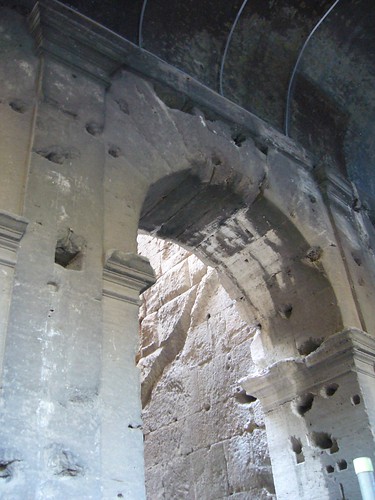 The Colosseum and its activities supported a substantial industry in the area. In addition to the amphitheatre itself, many other buildings nearby were linked to the games. Immediately to the east is the remains of the Ludus Magnus, a training school for gladiators. This was connected to the Colosseum by an underground passage, to allow easy access for the gladiators. The Ludus Magnus had its own miniature training arena, which was itself a popular attraction for Roman spectators. Other training schools were in the same area, including the Ludus Matutinus (Morning School), where fighters of animals were trained, plus the Dacian and Gallic Schools.
The Colosseum and its activities supported a substantial industry in the area. In addition to the amphitheatre itself, many other buildings nearby were linked to the games. Immediately to the east is the remains of the Ludus Magnus, a training school for gladiators. This was connected to the Colosseum by an underground passage, to allow easy access for the gladiators. The Ludus Magnus had its own miniature training arena, which was itself a popular attraction for Roman spectators. Other training schools were in the same area, including the Ludus Matutinus (Morning School), where fighters of animals were trained, plus the Dacian and Gallic Schools.Also nearby were the Armamentarium, comprising an armory to store weapons; the Summum Choragium, where machinery was stored; the Sanitarium, which had facilities to treat wounded gladiators; and the Spoliarium, where bodies of dead gladiators were stripped of their armor and disposed of.
Around the perimeter of the Colosseum, at a distance of 18 m (59 ft) from the perimeter, was a series of tall stone posts, with five remaining on the eastern side. Various explanations have been advanced for their presence; they may have been a religious boundary, or an outer boundary for ticket checks, or an anchor for the velarium or awning.
Right next to the Colosseum is also the Arch of Constantine.
Use
 The Colosseum was used to host gladiatorial shows as well as a variety of other events. The shows, called munera, were always given by individuals rather than the state. They had a strong religious element but were also demonstration of power and family prestige, and were immensely popular with the population. Another popular type of show was the animal hunt, or venatio. This utilised a great variety of wild beasts, mainly imported from Africa, and included creatures such as rhinoceros, hippos, elephants, giraffes, lions, panthers, leopards, crocodiles and ostriches. Battles and hunts were often staged amid elaborate sets with movable trees and buildings. Such events were occasionally on a huge scale; Trajan is said to have celebrated his victories in Dacia in 107 with contests involving 11,000 animals and 10,000 gladiators over the course of 123 days.
The Colosseum was used to host gladiatorial shows as well as a variety of other events. The shows, called munera, were always given by individuals rather than the state. They had a strong religious element but were also demonstration of power and family prestige, and were immensely popular with the population. Another popular type of show was the animal hunt, or venatio. This utilised a great variety of wild beasts, mainly imported from Africa, and included creatures such as rhinoceros, hippos, elephants, giraffes, lions, panthers, leopards, crocodiles and ostriches. Battles and hunts were often staged amid elaborate sets with movable trees and buildings. Such events were occasionally on a huge scale; Trajan is said to have celebrated his victories in Dacia in 107 with contests involving 11,000 animals and 10,000 gladiators over the course of 123 days.During the early days of the Colosseum, ancient writers recorded that the building was used for naumachiae (more properly known as navalia proelia) or simulated sea battles. Accounts of the inaugural games held by Titus in AD 80 describe it being filled with water for a display of specially trained swimming horses and bulls. There is also an account of a re-enactment of a famous sea battle between the Corcyrean (Corfiot) Greeks and the Corinthians. This has been the subject of some debate among historians; although providing the water would not have been a problem, it is unclear how the arena could have been waterproofed, nor would there have been enough space in the arena for the warships to move around. It has been suggested that the reports either have the location wrong, or that the Colosseum originally featured a wide floodable channel down its central axis (which would later have been replaced by the hypogeum).
Sylvae or recreations of natural scenes were also held in the arena. Painters, technicians and architects would construct a simulation of a forest with real trees and bushes planted in the arena's floor. Animals would be introduced to populate the scene for the delight of the crowd. Such scenes might be used simply to display a natural environment for the urban population, or could otherwise be used as the backdrop for hunts or dramas depicting episodes from mythology. They were also occasionally used for executions in which the hero of the story — played by a condemned person — was killed in one of various gruesome but mythologically authentic ways, such as being mauled by beasts or burned to death.
Today
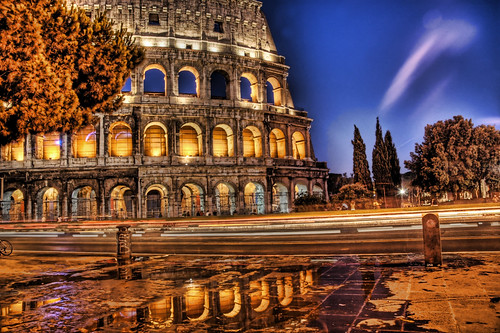 The Colosseum today is now a major tourist attraction in Rome with thousands of tourists each year paying to view the interior arena. There is now a museum dedicated to Eros located in the upper floor of the outer wall of the building. Part of the arena floor has been re-floored.
The Colosseum today is now a major tourist attraction in Rome with thousands of tourists each year paying to view the interior arena. There is now a museum dedicated to Eros located in the upper floor of the outer wall of the building. Part of the arena floor has been re-floored.Related video from YouTube:
Building Rome's Colosseum
Discover the engineering secrets behind Rome's Colosseum.
Colosseum in Rom
Colosseum - Rom
